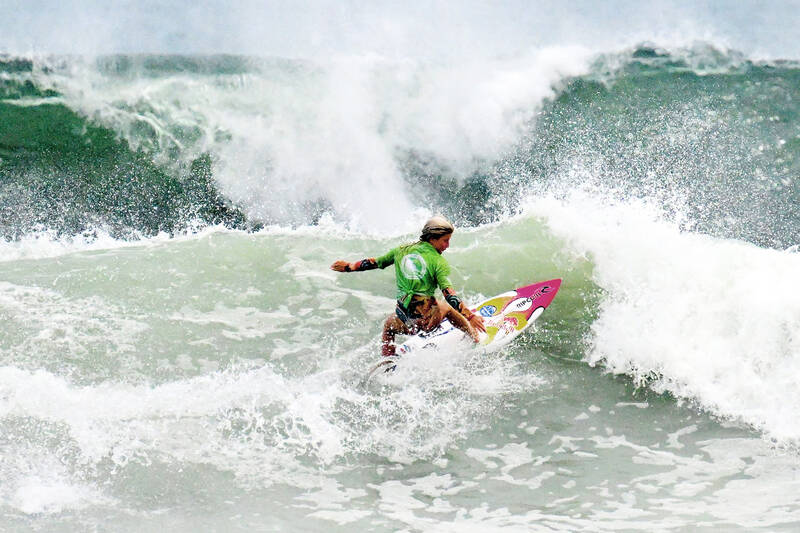Christian Meissner grew up far away from the ocean in Germany’s financial hub of Frankfurt, which meant long journeys to the coast to pursue his passion for surfing.
However, changing consumer preferences and demands for more sustainability within the surfing community has brought his focus closer to home.
The 51-year-old, whose day job is in construction, started making boards nine years ago in the landlocked city of Offenbach, near his hometown.

Photo: AFP
The idea was born after he helped his son craft a longboard for skateboarding, who could earn extra pocket money by selling similar boards to a local skateboard shop.
Unlike conventional surfboards, which rely on harmful materials, such as polyurethane foam, resin and fiberglass, Meissner’s business Mio — which stands for main ingredients: organic — uses wood from fast-growing paulownia trees.
In a sign that the material does the job, professional foil surfer Alex Soto won second place in hydrofoil freestyle at the Global Kitesports Association’s World Tour last year using a Mio board.
“Sustainability and high-performance can go hand in hand,” Meissner said.
The sport’s heavy ecological footprint jars with the nature-loving image of most surfers, and a growing number of boardmakers are trying to cater to their greener preferences.
It is a small step in what is likely to be a long journey to reduce the ecological impact of surfing, which for many requires long-distance flights to far-away destinations such as Hawaii, Indonesia or Australia.
While there have not been many attempts to quantify the sport’s exact effect on the environment, one researcher in 2009 said that a surfer’s carbon footprint was likely 50 percent higher than the average person’s, with the lion’s share of emissions coming from travel to the surf, and only 2 percent from board manufacturing.
With the ease of travel having increased significantly over the past decade, carbon emissions linked to surfing might have risen further.
Austria’s Woodboard, on Lake Neusiedl at the border to Hungary, is making similar efforts to Mio’s, drawing on Forest Stewardship Council-certified wood in its products.
Australia’s FCS Fins, one of the world’s largest makers of surfboard fins, uses recycled materials, while France’s Yuyo uses plastic trash to 3D print new boards.
Many of those companies have said that the toxic petrochemicals used in conventional surfboards can harm workers and the environment while they are made.
They have the potential to release harmful foam particles into the ground and the ocean if they are abandoned on a beach or in a landfill.
“The dust from shaping petrochemical material made me sick, so I started experimenting,” Meissner said, who started out making boards with traditional polyurethane-based foam, before switching to paulownia wood four years ago.
Paulownia trees are native to Asia, but have been grown across parts of Europe and North America. They can grow about 3m to 6m in a single year and reach maturity within 10 years. They produce lightweight and warp-resistant wood — perfect for kite boards and a range of other products, including musical instruments.
They also have stronger drought tolerance and carbon-capture properties, making them ideal for countries looking to offset carbon dioxide emissions.
“The surfboard industry has been one of our main consumers since we started commercializing European-grown paulownia wood,” said Anja Hartelt, a representative for iPaulownia, a Spanish paulownia wood supplier. “The demand has kept increasing over the years since surfers become more conscious on sustainability.”
With surfing rising in popularity — globally and at Germany’s rugged northern coasts — sustainably-sourced alternatives would help to supply a watersports equipment market that is expected to surpass US$13 billion this year, research firm Statista said.
Prominent surfers are throwing their weight behind efforts to make the industry greener.
Seven-time British surfing champion Lucy Campbell told the BBC that top brands “need to change,” and that she has turned down sponsorships from brands that she did not consider sustainable.
“You do want to encourage people to get outdoors,” she said. “But at the same time — at what cost to the planet?”

The Burmese junta has said that detained former leader Aung San Suu Kyi is “in good health,” a day after her son said he has received little information about the 80-year-old’s condition and fears she could die without him knowing. In an interview in Tokyo earlier this week, Kim Aris said he had not heard from his mother in years and believes she is being held incommunicado in the capital, Naypyidaw. Aung San Suu Kyi, a Nobel Peace Prize laureate, was detained after a 2021 military coup that ousted her elected civilian government and sparked a civil war. She is serving a

China yesterday held a low-key memorial ceremony for the 1937 Nanjing Massacre, with Chinese President Xi Jinping (習近平) not attending, despite a diplomatic crisis between Beijing and Tokyo over Taiwan. Beijing has raged at Tokyo since Japanese Prime Minister Sanae Takaichi last month said that a hypothetical Chinese attack on Taiwan could trigger a military response from Japan. China and Japan have long sparred over their painful history. China consistently reminds its people of the 1937 Nanjing Massacre, in which it says Japanese troops killed 300,000 people in what was then its capital. A post-World War II Allied tribunal put the death toll

‘NO AMNESTY’: Tens of thousands of people joined the rally against a bill that would slash the former president’s prison term; President Lula has said he would veto the bill Tens of thousands of Brazilians on Sunday demonstrated against a bill that advanced in Congress this week that would reduce the time former president Jair Bolsonaro spends behind bars following his sentence of more than 27 years for attempting a coup. Protests took place in the capital, Brasilia, and in other major cities across the nation, including Sao Paulo, Florianopolis, Salvador and Recife. On Copacabana’s boardwalk in Rio de Janeiro, crowds composed of left-wing voters chanted “No amnesty” and “Out with Hugo Motta,” a reference to the speaker of the lower house, which approved the bill on Wednesday last week. It is

FALLEN: The nine soldiers who were killed while carrying out combat and engineering tasks in Russia were given the title of Hero of the Democratic People’s Republic of Korea North Korean leader Kim Jong-un attended a welcoming ceremony for an army engineering unit that had returned home after carrying out duties in Russia, North Korean state media KCNA reported on Saturday. In a speech carried by KCNA, Kim praised officers and soldiers of the 528th Regiment of Engineers of the Korean People’s Army (KPA) for “heroic” conduct and “mass heroism” in fulfilling orders issued by the ruling Workers’ Party of Korea during a 120-day overseas deployment. Video footage released by North Korea showed uniformed soldiers disembarking from an aircraft, Kim hugging a soldier seated in a wheelchair, and soldiers and officials